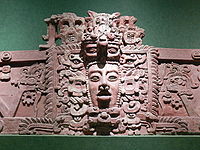- Maya rulers
-

Maya civilization People · Languages · Society Religion · Mythology · Sacrifice Cities · Architecture · Calendar Stelae · Textiles · Trade Pre-Columbian Music · Writing History Preclassic Maya Classic Maya collapse Spanish conquest of Yucatán Spanish conquest of Guatemala Mayan kings were the centers of power for Mayan civilization. Each Mayan city-state was controlled by a dynasty of kings, who collectively drove the empire forward.
Contents
Symbols of power
Every single Mayan king created some form of monument to prove his power; some still stand, and some are in ruin.
Mayan kings felt obliged to legitimize their claim to power. One of the ways to do this was to build a temple or pyramid. The Temple of the Giant Jaguar is a notable example. This temple was built during the reign of Yik'in Chan K'awiil. Kawiil was ruler of a city called Tikal, but just a few miles away was Calakmul, one of Tikal's rivals. The Temple of the Giant Jaguar was designed to show Calakmul that Kawiil would not be deposed easily or quickly. Another king named K'inich Janaab' Pakal would later carry out this same show of power when building the Temple of Inscriptions.
Succession
Mayan kings were considered to be godlike, so when a ruler died and left no heir to the throne, the result was usually war and bloodshed. King Pacals precursor, Pacal I, died upon the battlefield. However, instead of the kingdom erupting into chaos, the city of Palenque, a Mayan capital city in southern Mexico, invited a young prince from a different city-state. The prince was only twelve years old. His name was Pakal. Pakal's Temple of Inscriptions towers still today, amid the ruins of Palenque, as the supreme symbol of Pakal's influence and power in Palenque.
Expansion
Pacal and his predecessors not only built elaborate temples and pyramids. They expanded their city-state into a thriving empire.Under Yikin Chan Kawiil, Tikal conquered Calakmul and the other cities around Tikal, forming what could be referred to as a super city-state. Pacal achieved in creating a major center for power and development.
See also
- Maya stelae
- Maya queens
Further reading
Categories:
Wikimedia Foundation. 2010.
